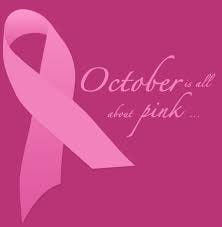Let's Be Aware
October 9, 2014

By: Tekeisha Meade
Everyone gets excited as the month of October rolls around, especially if they’re in the North Shore, in the area of Salem. Salem is well known for its great Halloween shops and the unlimited events held in downtown leading up to the party on Halloween. Although Halloween is very exciting, other things do exist during the month of October such as Breast Cancer Awareness. It may be more on the serious spectrum of all things that happen in October, especially in the North Shore, but it’s still very important.
What is Breast Cancer?
A group of abnormal cells in the breast that grow and invade surrounding tissues causing a build up of cells, creating a lump or tumor.
Why is this important?
Breast Cancer is the second leading cause of death among women and is the most commonly diagnosed cancer as well. According to the National Breast Cancer Foundation’s website, one in eight women will be diagnosed in their lifetime (over 220,000 women in the U.S, 40,000 of which will die). To see just how great of a statistic that is count the number of women in one of your classes, if there are 16 women, 2 of them will be diagnosed with Breast Cancer. On a different note, many men don’t realize that they can also get breast cancer even though it is rare. It is estimated that over 2,150 men will be diagnosed and about 410 will die each year. Knowing how and why breast cancer is the second leading cause of death in women and how it occurs in men is important to know as we all get older, regardless if you are 21, 37 or 55.
Cause of Breast Cancer:
The cause is still very unknown, however, it is due by the damage to a cells DNA (a mutation in BRAC1 AND BRAC2 gene).
Risk Factors:
Gender – it occurs more often in women than men
Race – Caucasian women are diagnosed higher than any other race
Family history and genetic factor – if your mother, sister, father or child was diagnosed, you have a higher risk
Menstrual history – early menstruation (before 12) and late menopause (after 55)
Genome Change – mutation in the BRAC1 & BRAC2. That can be determined through a genetic test
Dense breast tissue – makes lumps harder to detect
Lack of physical activity
Poor diet
Being overweight/obese
Drinking alcohol
Symptoms/Signs (can be detected by breast self-exams or during physical by your primary doctor)
Change in how breast or nipple feels: tenderness, lump in or near breast or underarm and change in skin texture
Change in breast or nipple appearance: unexplained change in size/shape, swelling, shrinkage, nipple inversion, areola/nipple suddenly red, scaly or swollen and clear or bloody discharge.
What can you do?
Maintain a healthy weight
Stay physically active
Don’t smoke
Limit consumption of alcohol
Perform monthly breast self- exams
Receive yearly physical exams
Ask about your family history of breast cancer
Do a genetic test to see if you have a mutated gene
Wear pink AT LEAST one day in October to support Breast Cancer Awareness!
For more information go to the Health and Counseling center in the Ellison Building, Salem Hospital, North Shore Medical Center, North Shore Community Health Center or nationalbreastcancer.org.
Contributor’s Note: Tekeisha Meade is a senior English major with a concentration in Creative Writing.


